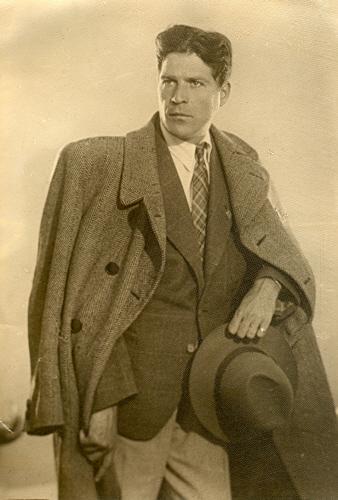
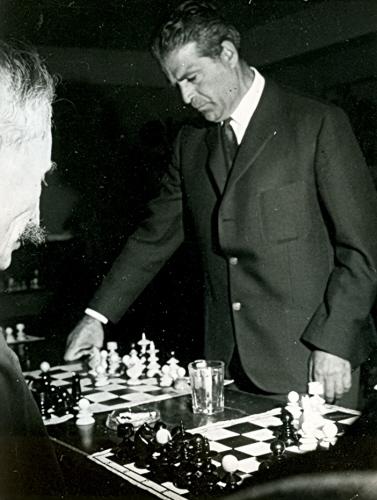
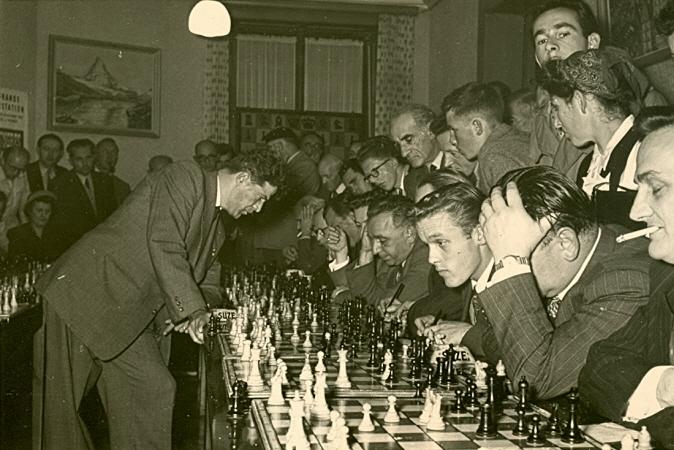
When contacting us by e-mail, correspondents are asked to include their name and full postal address and, when providing information, to quote exact book and magazine sources. The word ‘chess’ needs to appear in the subject-line or in the message itself.
| First column | << previous | Archives [43] | next >> | Current column |
Frederic Friedel (Hamburg, Germany) has sent us three photographs of Andor Lilienthal:



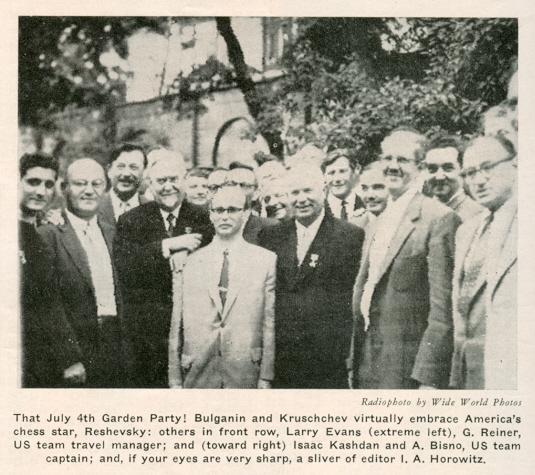
Larry Crawford (Milford, CT, USA) draws attention to the above photograph on page 227 of the August 1955 Chess Review and two near-identical shots which have appeared on websites (ChessBase and the Chess Café).
Hassan Roger Sadeghi (Lausanne, Switzerland) mentions that in a tribute on page 5 of his book Comment jouer les fins de parties aux échecs (Lille, 1952) Znosko-Borovsky remarked that the late Gaston Legrain had undertaken the French versions of four of his books. The title page of that volume did not refer to a translation but stated ‘Version française par Gaston Legrain’.
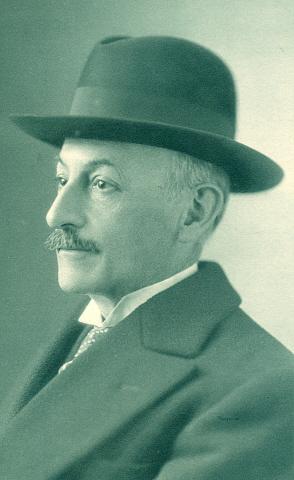
Gaston Legrain
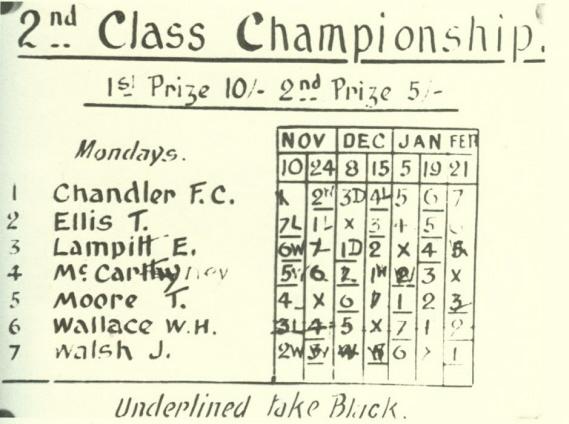
The significance of this pairing table is explained in our new feature article Chess and the Wallace Murder Case.
Rod Edwards (Victoria, BC, Canada) asks about two nineteenth-century Dutch players. Firstly, he quotes to us various sources which refer to ‘B.W. Blijdenstein’ and ‘W.J. Blijdensteijn’ in connection with the Amsterdam, 1851 tournament, while the following have been found regarding The Hague, 1873: ‘Blijdenstein’, ‘Blydenstein’, ‘B.W. Blijdensteijn’, ‘B.W. Blijdenstein’ and ‘A.H. van Blijdenstein’. A similarly-named player also participated in Amsterdam, 1874. Our correspondent notes that Jeremy Gaige’s Chess Personalia lists only A.H. van Blijdenstein (died in Rotterdam on 20 March 1920) and that there exists a book Benjamin Willem Blijdenstein (1780-1857) Damauteur en damproblemist by K.W. Kruijswijk (Rosmalen, 1988).
With regard to Amsterdam, 1851, Mr Edwards also cites references to ‘C. Naret Oliphant’ and ‘C. Narest Oliphant’ (died 1867, aged 88), as well as ‘H.W. Oliphant’ (died 1882, age 61). In relation to the former, he points out that the Perthshire Heritage site mentions ‘Carel Naret Oliphant’ (born on 19 February 1781 and died in 1868).
Can any readers help clarify the identity of these players?
Further to our feature article Napoleon Bonaparte and Chess, Colin Rose (Sydney, Australia) draws attention to his webpage Chess on Stamps, which discusses a picture of Napoleon used on a Paraguayan stamp.
Manuel López (Mexico City) raises the subject of Capablanca v Tylor, Nottingham, 14 August 1936. After 1 Nf3 Nf6 2 c4 g6 3 Nc3 Bg7 4 g3 O-O 5 Bg2 d6 6 d4 Nc6 7 O-O Bg4 8 d5 Bxf3 9 exf3 Ne5 10 Qb3 Nfd7 11 Be3 b6 12 Nb5 c5 13 dxc6 Nxc6 14 f4 Qc8 15 Qa4 Nc5 16 Bxc5 dxc5 17 Nc3 Nd4

Alekhine’s tournament book (page 95) gave White’s 18th move as Rfe1.
Our correspondent believes that Capablanca played 18 Rae1 because otherwise, as Kenneth Frey Beckman has pointed out, the game continuation 18...e6 19 Re3 Rb8 20 Qxa7 would have allowed Black to win the exchange with 20...Nc2. Yet Tylor played 20...Rd8, and Alekhine made no comment.
We have copies of Capablanca’s score-sheets of 11 of his games at Nottingham, but unfortunately not the Tylor one. However, contemporary publications support Mr López’s belief that it was the queen’s rook that Capablanca moved to e1; for example, the October 1936 BCM (page 505), Chess Review, September 1936 (page 204) and Hans Kmoch’s tournament book (page 26).
Albert Frank (Brussels) asks if precise facts are available about the Maróczy v Korchnoi ‘spiritualist story’. We touched on it in C.N. 5162 (regarding a sideline: the spellings Romi/Romih), but does any reader know where the essentials of the affair have been set out, plainly and factually? And when did any mention of Maróczy v Korchnoi first appear in print?
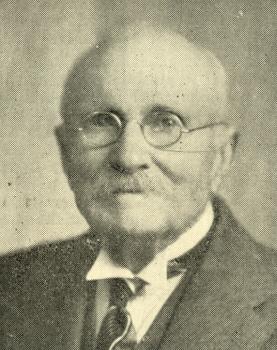
C.N. 5402 asked the identity of this chessplayer, an opponent of Adolf Anderssen. A clue provided was the date of the photograph: 1950.
It is Frederick Karl Esling (1860-1955). The picture was published on page 150 of the 1 July 1950 issue of Chess World, and pages 149-161 featured much material on him, including a reference on page 150 to a letter contributed by him to the March 1942 issue of the Australasian Chess Review:
‘The most striking thing about the letter was that although he mentioned having played the great Adolf Anderssen – and he is now probably the only living man who did – he omitted to mention that he had won the game. Stranger still, after his return home to Australia in 1879 he did not mention the game, and 40 years went by before a fellow Australian, Gundersen, discovered it in two German books, and Esling’s guilty secret was out.’
Pages 152-153 gave further particulars:
‘Those who wish to see the offhand game Esling won at the age of 18 from Anderssen in 1878 are referred to the Australasian Chess Review of 1942, page 152. It was published in the Book of the West German Chess Association’s congresses of 1876-7-8, and afterwards in the Book of Anderssen’s Collected Games (German language). It also appears in E.I. Rosenblum’s brochure, Seventy Years of Victorian Chess, published in 1926.’
From page 151:
‘... he [Esling] nonchalantly told me – as if it were just the other day though in fact two-thirds of a century had intervened – of dining with Wilfried Paulsen, brother of Louis Paulsen, Morphy’s first rival. Wilfried was a minor master. “Louis takes chess too seriously”, said Wilfried to the young Australian student. “If Louis loses a game, it is the end of the world ... He will not drink wine, or do anything that might affect his chess ... To me a loss is nothing.”’
Page 152 quoted Esling on Adolf Anderssen:
‘Anderssen, a professor of mathematics, was a pleasant, amiable man who had won the first international tournament, London, 1851. He was the quickest mover I have seen amongst those using clocks, and at any time-limit over 30 moves an hour would, I believe, have been invincible. He generally finished his match-game early and, having disposed of his score-sheet, set up the pieces and was ready to play anybody, at any odds asked for. He told me that he could place opponents in the four other continents, but thought that I was the first Australian he had met.’

Frederick Karl Esling
The two photographs of Esling given here appeared not only in the 1 July 1950 Chess World but also in his obituary on pages 167-169 of the August 1955 issue, which furthermore gave the score of his victory over Anderssen, nowadays well known. (Chess World, though, mistakenly suggested that Anderssen himself had brought out a collection of games which included it.)
Further information about Esling is provided on pages 334-336 of the August 1895 BCM.
Luca D’Ambrosio (Bolzano, Italy) quotes from the regulations for Meran, 1924, which stipulated that within an hour of the end of each game both players had to deliver a correct, legible score-sheet, which then became the organizers’ property:
‘12. Spätestens eine Stunde nach Beendigung der Partien haben beide Spieler dem Turnierleiter oder dessen Stellvertreter eine richtige und lesbare Partieaufzeichnung abzuliefern.
13. Die Partien sind Eigentum des Kur- und Verkehrsvereins und des Zentralpropagandakomitees Meran.’
Source: Programmheft des I. Internationalen Schachmeisterturniers Meran 1924, page 14.
Mr D’Ambrosio also asks when the term ‘Meran Variation’ (or ‘Meran Defence’) first appeared in chess literature. He cites a note to the game Bogoljubow v Maróczy (after 1 d4 d5 2 c4 c6 3 Nf3 Nf6 4 e3 e6 5 Nbd2) on page 318 of the German edition of Alekhine’s New York, 1924 tournament book:
‘Offenbar um die Meraner Variante (5 Sb1-c3 Sb8-d7 6 Lf1-d3 d5-c4:! usw.) zu vermeiden.’
The note appears on page 232 of the English edition.
We add that Das Grossmeister-Turnier New York 1924 was published in or around February 1925. It was reviewed on page 69 of the March 1925 Deutsche Schachzeitung and on pages 42-43 of the March 1925 American Chess Bulletin. The latter source also stated that publication of the English-language edition was imminent:
‘After many unforeseen and more or less vexatious delays, of which translation from the German was by no means the least, the home edition of the New York Tournament Book has at last reached the bindery ...’
The Meran tournament in question took place in February 1924, and our correspondent is therefore seeking occurrences of a term such as ‘Meran Variation’ between that time and the appearance of the New York tournament book approximately one year later.
Two literary figures who played chess together were Pavel Muratov (1881-1950) and Nina Berberova (1901-93), but so far we have found no more than a flat statement to that effect, on pages 164-165 of the latter’s memoirs, The Italics Are Mine (London, 1969). It relates to the summer of 1923, in Prerow:
‘I would play chess with Muratov and carry on long conversations ...’
The plates section features both of them in a group photograph (‘Russian writers in exile in Berlin, September 1923’). Can readers find any further information about their interest in chess?
Peter de Jong (De Meern, the Netherlands) writes:
‘Benjamin Willem Blijdenstein (1780-1857) was the founder of Blijdenstein & Co, a textile company in eastern Holland (Enschede). For clarity he is described in this note as “the first”. One of his 14 children was Benjamin Willem Blijdenstein (born in Enschede on 18 February 1811 and died on 21 May 1866). He (“the second”) married in 1836, and one of his three children was also named Benjamin Willem Blijdenstein (“the third”). His dates were 1839-1914.
“The first” is known as the writer of several books on draughts, and the family had a considerable interest in both chess and draughts. The B.W. Blijdenstein who was one of the prize-winners at Amsterdam, 1851 is unlikely to have been “the first” because he had severe health problems in his final years. A player named B.W. Blijdenstein also participated in The Hague, 1873 (he was the joint winner with Gifford) and Amsterdam, 1874. From the birth and death dates it would seem that “the second” played at Amsterdam, 1851 and “the third” in the 1870s tournaments.
A.H. van Blijdenstein, who died in 1920 and is mentioned in Gaige’s Chess Personalia, is not related.
Carel Naret Oliphant (Naret was his second forename, and Oliphant the family name) was born in Yerseke (Zeeland) on 19 February 1781 and died on 10 January 1867 (being buried in Leiden). A pharmacist, he was the founder of one of the old chess clubs in The Netherlands (Palamedes in Leiden, in 1846) and also participated in Amsterdam, 1851. Source: Het loopt ongenadiglijk Mat by H.J.G.M. Scholten (Bilthoven, 1999), pages 288-293.’
Alejandro Pablo Souto (Buenos Aires) reports that the Maróczy v Korchnoi ‘spiritualist’ game was the subject of a feature on page 23 of the November 1988 Revista Internacional de Ajedrez. It quoted a Reuters dispatch from Reykjavik which had appeared in El País of 6 October 1988 and included a report on statements allegedly made by Korchnoi to the Icelandic daily newspaper Tíminn.
On the same page of the Revista Pablo Morán made a few light comments and gave the game-score up to Black’s 27th move.

The longest account of the affair that we have found so far is entitled ‘A New Meaning for “Soul Mate”’.
Juan Carlos Sanz Menéndez (Alcorcón, Spain) submits the following:
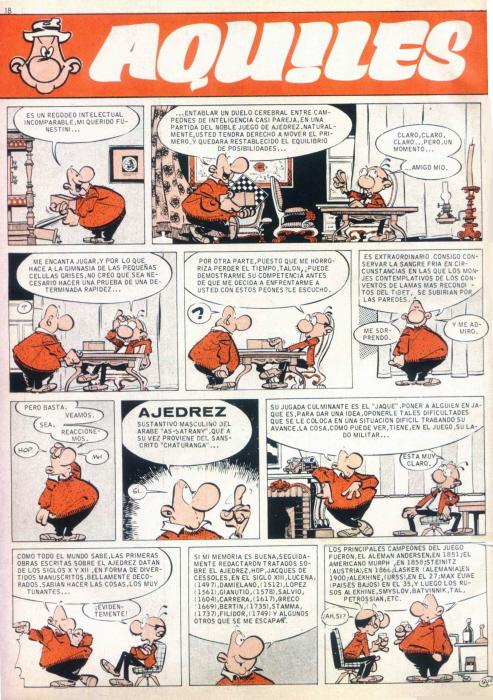
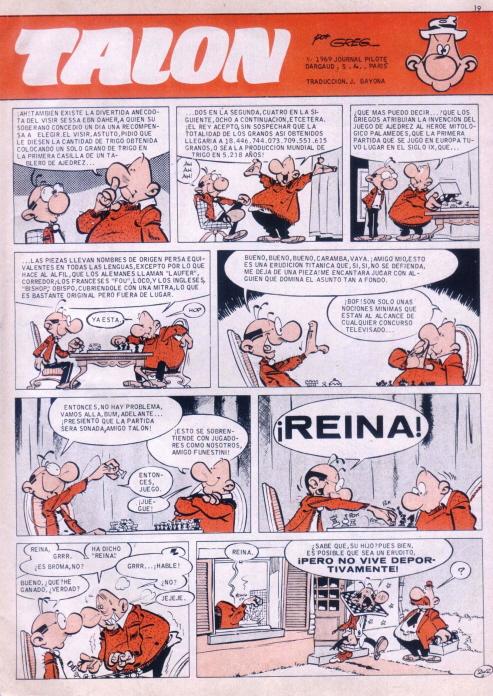
‘Aquiles Talón’ on pages 18-19 of Gran Pulgarcito, number 50 (1970), the original having appeared in the French magazine Pilote
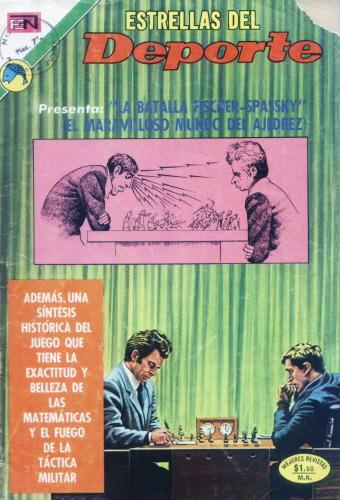
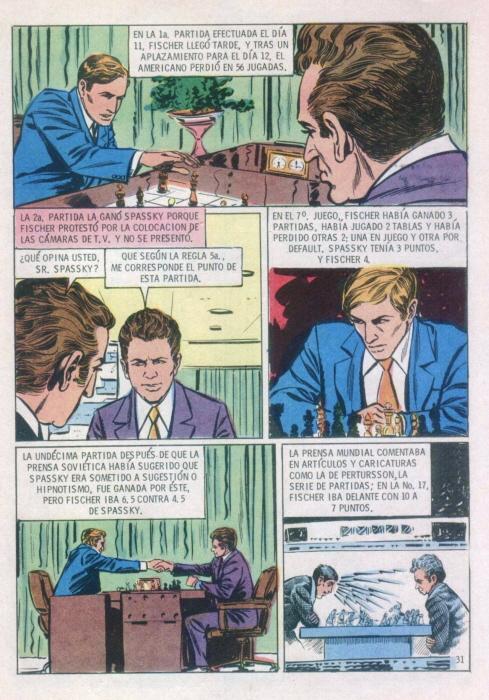
‘La Batalla Fischer-Spassky/El maravilloso Mundo del Ajedrez’ in Estrellas del Deporte (Mexico, 1973), page 31
Michael McDowell (Westcliff-on-sea, England) draws attention to the following on page 31 of Der Schach Komponist (subtitled ‘Johann Berger als Schachtheoretiker und Partiespieler’) by Helmut Roth (Graz and Stuttgart, 1982):

Our correspondent asks on what grounds it is suggested that the player who finished 11th in the 1931 tournament in Brünn (Brno) was Johann Berger (1845-1933).
We see no grounds for linking Johann Berger to the tournament, although he was named as the participant on page 248 of Hundert Jahre Schachturniere by P. Feenstra Kuiper (Amsterdam, 1964).
A contemporary source such as page 142 of the August-September 1931 Československý Šach (which gave the tournament crosstable) put ‘Ing. Berger’, and page 253 of the August 1931 Wiener Schachzeitung gave ‘Ing. Berger (Prag)’.

Johann Berger
Pete Tamburro (Morristown, NJ, USA) reverts to Alfred Kreymborg’s article ‘Chess Reclaims a Devotee’, which was reproduced on pages 6-18 of The Fireside Book of Chess by I. Chernev and F. Reinfeld (New York, 1949) and has been discussed in various C.N. items (see the Factfinder).
He provides the exact reference for the first known publication (The American Mercury, August 1930, pages 446-453) and points out that after the paragraph naming Rosen, Rosenbaum, Rosenfeld, Rosenthal and Rosenzweig the following text is absent from the Chernev/Reinfeld book (see page 11):
‘I had done well to give up tournament chess, but nothing less than an idiotic whim had forced me to desert my old friends. I cannot attempt to describe how their welcome stirred me. The affections are outmoded these days: sentiment has been gobbled down by the sciences and by dollars mounting on dollars. One has to be hard-boiled. But hard-boiled here? Impossible. The chess world anywhere is a world unto itself, and when a gang of dark Jews welcome a goy with unrestraint, there’s nothing to do but enthuse. For nowhere else is the goy held in greater contempt. The man who dubbed chess Jewish athletics, dubbed it correctly. With rare exceptions, Jews have graced Caissa’s throne for a century past. And what, over on Second avenue, did they used to call the insignificant pawn? A goy, a little goy! But even the Gentile rises to honors in time. Look at your Jewish Who’s Who and you’ll find me there. And why not? I bragged about that once too often and was hailed by a Jew: “Dirty climber!”’
We note that the passage was included by Edwin Valentine Mitchell in his anthology The Art of Chess Playing (New York, 1936). See pages 20-21.
Mr Tamburro also refers to a poem by Alfred Kreymborg which was published on page 4 of his book Manhattan Men (New York, 1929) and on page 194 of The Selected Poems 1912-1944 of Alfred Kreymborg (New York, 1945):
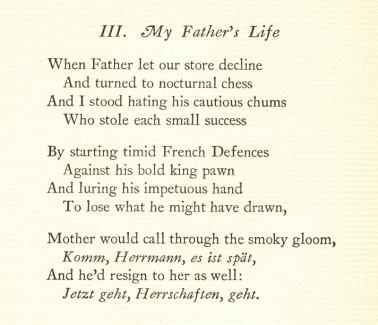
C.N. 3693 noted that volumes inscribed by Fred Reinfeld are rare. A further specimen in our collection comes from the book he co-authored with Reuben Fine, Dr Lasker’s Chess Career: Part I, 1889-1914 (New York, 1935):

A biographical note on Richard Wayne would be welcomed.
From Robert John McCrary (Columbia, SC, USA):
‘On page 17 of the Chicago, 1874 tournament book, rule 11 reads:
“The winner of a game shall furnish a correct copy of such game to the Committee of Management before the commencement of play next day, under penalty of having the game scored against him. In drawn games, the player moving first shall furnish such copy under the same penalty.”
Of course, the reference to “correct copy” does not necessarily imply the original score-sheet, which often contains errors in notation.’
Regarding the article about L. Nardus by Jonathan Lopez in the December 2007 issue of Apollo, Peter van Hooren (Kortenhoef, the Netherlands) points out the following note on page 80 of the magazine:
‘Stéphane Bourgeois died in 1899; his brother Gaspard in 1904. Within months of Gaspard’s death, Nardus, who was then 36 years old, married Stéphane’s daughter, who was 17. Nardus thereby gained a stake in the gallery. It would operate (inconsistently) under the name of Nardus & Bourgeois until 1924.’
Miquel Artigas (Sabadell, Spain) draws attention to Himno al ajedrez, by Ernesto Jaumeandreu Opisso (Barcelona, 1928).
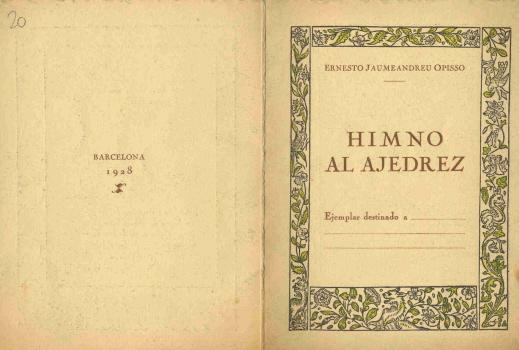
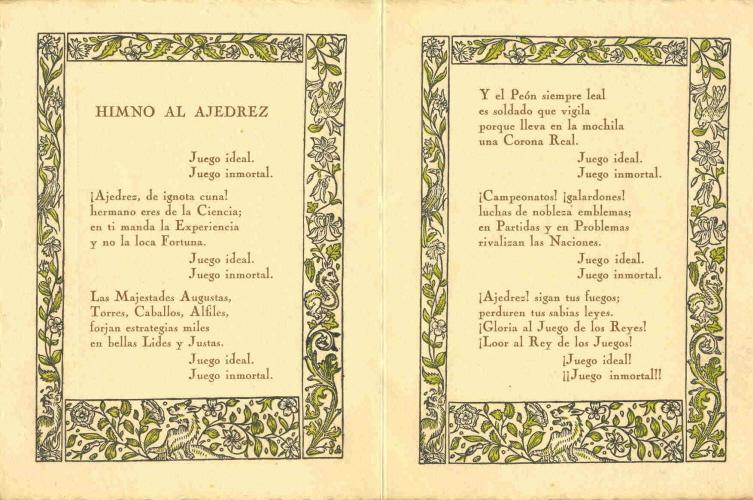
Mr Artigas also provides, from a postcard, a better copy of the illustration given in C.N. 5134:
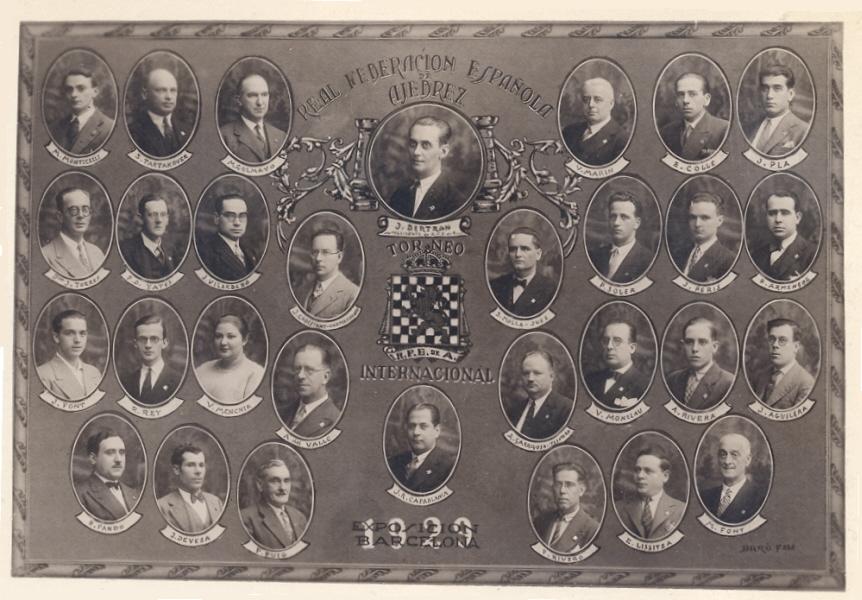
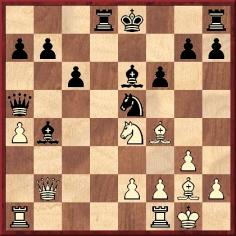
This position (White to move) arose in the ninth match-game between Capablanca and Euwe in Amsterdam on 8 July 1931. The Cuban played 18 Rfb1 and the following year he discussed the game in a lecture in Havana which was reported on pages 242-243 of the August-September 1932 El Ajedrez Americano. He took issue with Znosko-Borovsky for the way he had criticized 18 Rfb1 ‘in his latest book on errors by grandmasters’. The Argentinian magazine, whose article was entitled ‘Capablanca refutes Znosko-Borovsky’, related (in our translation):
‘All the commentators – added Capablanca – had agreed on one assumption: that I should lose by means of the following continuation: 18...Nc4 (in the game Euwe played 18...O-O) 19 Qxb4 Rd1+ 20 Rxd1 (If 20 Bf1 Qxb4, followed by 21...Rxa1 and 22...Bh3.) 20...Qxb4 and Black would win.
This is clear and logical, but what the critics did not see, as our champion pointed out in his instructive and masterly lecture, is that White would have answered 18...Nc4 with 19 Nxf6+ ...
The main variation, according to Capablanca, would be 19...Kf7 (if 19...gxf6 then 20 Qxf6, attacking the bishop and the king’s rook and winning rather easily, and if instead 19...Ke7 then 20 Qxb4 with check) 20 Qxb4 Rd1+ 21 Rxd1 Qxb4 22 Ne4! and – still according to Capablanca – White should win despite the queen sacrifice. Black has many weak points, and the threats Rab1 and Ng5+ are difficult to neutralize. If, for instance, 22...h6, there would follow 23 Rab1 Qe7 (To protect the b-pawn.) 24 Bd6! Qd7 25 Nc5, followed by 26 Rxb7+, with gradual, decisive pressure.
Capablanca showed many variations to prove that after 22 Ne4!! it is only White who has winning chances.
Position (analysis) after 22 Ne4
Nonetheless, Capablanca declared that the critics were right to consider 18 Rfb1 inferior to 18 Rab1 (as El Ajedrez Americano mentioned in its annotations) but that although the move played by him was not the best it was far from leading to defeat.’
On page 279 of A Primer of Chess (London, 1935) Capablanca supplied the following assessment of 18 Rfb1:
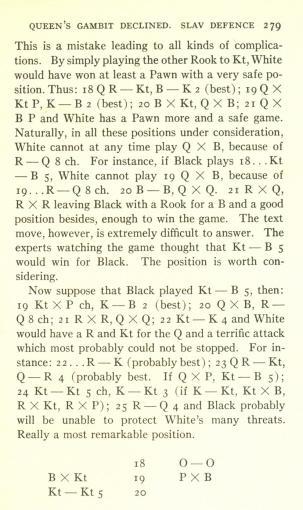
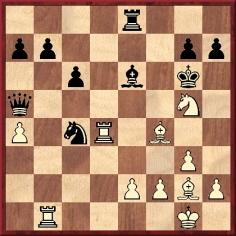
Position after 25 Rd4 (analysis by Capablanca)
On page 213 of Capablanca’s Hundred Best Games of Chess (London, 1947) Harry Golombek gave the line ‘18...Nc4! and now if 19 Nxf6+ Kf7! 20 Qxb4 Rd1+ 21 Rxd1 Qxb4 22 Ne4 h6 23 Rab1 Qe7 24 Nd6+ Nxd6 25 Bxd6 Qd7 26 Be5 Qc8 and Black, having weathered the storm, should win easily enough’, without mentioning Capablanca or any other previous annotator. On page 237 of the algebraic edition (London, 1996) John Nunn added a footnote: ‘White can improve by 24 Bd6! winning the b7-pawn, after which White has a clear advantage. A more accurate 22nd move (possibly 22...Kg6) might give Black an edge, but he is certainly far from winning.’ It should be recalled that 24 Bd6! was given by Capablanca during his lecture.
Beyond the above analytical complexities – and see too page 37 of Schachmeister wie sie kämpfen und siegen by Alfred Brinckmann (Leipzig, 1932) – we should welcome clarification of Znosko-Borovsky’s involvement: where exactly did he criticize Capablanca’s play against Euwe at the time? We can find no book of his that would fit the bill, so was ‘book’ an error for ‘article’?
Who is the player giving this simultaneous exhibition?
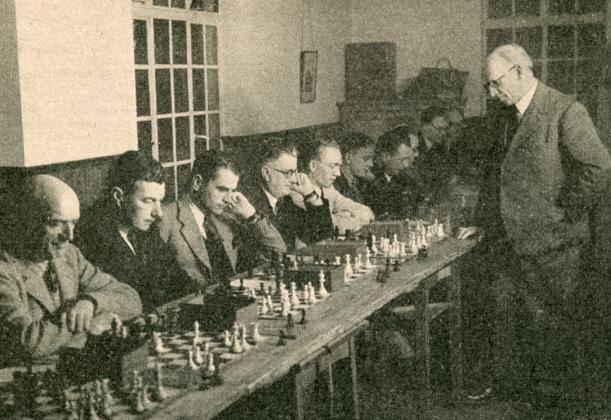
Charles Sullivan (Davis, CA, USA) asks about the last-round game Alekhine v Salwe, Hamburg, 6 August 1910, which is given as follows on pages 51-52 of Alexander Alekhine’s Chess Games, 1902-1946 by Leonard M. Skinner and Robert G.P. Verhoeven (Jefferson, 1998):
1 d4 d5 2 Nf3 Nf6 3 c4 e6 4 Bg5 Be7 5 e3 b6 6 Nc3 Bb7 7 cxd5 Nxd5 8 Bxe7 Qxe7 9 Bb5+ c6 10 Bd3 Nd7 11 O-O O-O 12 Rc1 Rfc8 13 Qd2 c5 14 Nxd5 Bxd5 15 e4 Bb7 16 Qe2 cxd4 17 Nxd4

17...Ne5 18 Rfd1 g6 19 f3 Kh8 20 Kh1 Kg8 21 Kg1 Kh8 22 Kh1 Kg8 Drawn.
Mr Sullivan comments:
‘If the game-score is correct, the last five moves by Alekhine (starting with 18 Rfd1) are blunders which would lose a piece to, for example, 18...Rxc1 19 Rxc1 Rd8. Can you shed any light on this?’
The Skinner/Verhoeven volume reproduced the game, faithfully, from pages 147-148 of the Hamburg, 1910 tournament book, but we wonder whether Black’s 17th move was 17...Nc5 rather than 17...Ne5, as the remainder of the game would then make more sense. 17...Nc5 was, in fact, the move given on page 122 of Alexander Alekhine I Games 1902-1922 (Sofia, 2002), but we have yet to find this short draw in any contemporary source other than the tournament book.
Our latest feature article, The Horowitz-Wellmuth Affair, concerns a mystery which may prove easier to solve if some biographical information about Francis J. Wellmuth can be found. At present we do not even know when and where he died.

Jan Kalendovský (Brno, Czech Republic) reports that the participant in the Brno, 1931 tournament was Vladimír Berger (as shown by, for instance, Národní listy, 9 August 1931). Our correspondent also provides the following illustration:

Concerning the threat/execution smoking anecdote (see A Nimzowitsch Story) Michael McDowell (Westcliff-on-sea, England) points out that an article by Jacqueline Piatigorsky ‘Growing As We Age’ contains the surprising claim that she witnessed the incident:
‘I remember watching a chess grand master play in a tournament. He was allergic to smoke.
When his opponent pulled from his pocket a big cigar and laid it on the table beside him, the grand master looked at the cigar. He kept staring at it. He was so upset he could not concentrate on his game. Finally he called the referee. His opponent smiled.
“I am not smoking”, he said.
“But”, said the grand master, “he is threatening to smoke.”’
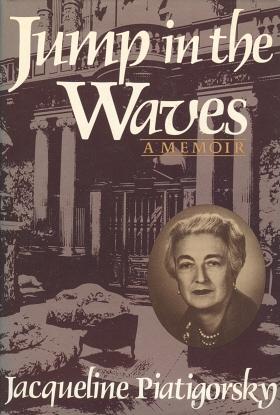 We add that there are many references to chess in
the memoir of Jacqueline Piatigorsky (née de Rothschild), Jump
in the Waves (New York, 1988). Since the book has no index,
a list of the main references to the game is presented below,
together with some quotes:
We add that there are many references to chess in
the memoir of Jacqueline Piatigorsky (née de Rothschild), Jump
in the Waves (New York, 1988). Since the book has no index,
a list of the main references to the game is presented below,
together with some quotes:
‘In an attempt to become part of the outside world, I turned toward my old interest and went to a chess club, only to face another humiliation. I took a board in a simultaneous exhibition. When I reached a critical position I must have shown anxiety and fear, for a stranger behind me said, “Move here”. I followed his advice, and won the game. At the end the Grand Master said, pointing at me, “She played a good game.”
“I helped her”, the man said. Though he had shown me only one move, I felt ashamed. I arranged for the Grand Master to come and give me lessons. He came two or three times and I improved.’
‘But my real love was chess. Chess was part of my blood. Of course, in the winter there was no-one to play with in Elizabethtown, so through a chess magazine I started to play by correspondence, entering tournaments in which one played six games at the same time. That was perfect for me. I had a small pocket set which I always carried with me and I studied each position in great depth. Before mailing out a move I was so anxious not to make an error that even alone in the woods my heart was beating hard. I went over each variation again and again. I had to win.’
‘The violinist Louis Persinger also had a summer home in Elizabethtown; he was a very good chessplayer, so naturally we played. I kept moving the pieces on the board when I analyzed positions by myself: I tried a variation, put the pieces back and restudied all possibilities, but in a regular game that isn’t possible. One has to visualize the different positions in one’s head. I had no experience of playing across the board, so I lost, and I kept losing each time I played him. I was back in childhood. My mother had said, “I wish I also had a daughter that could win!” I was a loser, and I was angry. Persinger gave me a book on openings, so for the first time I started to study the game.’
‘I continued to play chess and went to the club from time to time. ... In chess one deals with a cross-section of people. I played with a gardener and I played with Marcel Duchamp and Prokofiev ...’
‘When things seemed difficult, chess was always there. I started to solve the weekly problems from the Los Angeles Times and sent in the results. The chess editor then was Herman Steiner, who had been United States champion in 1948.’
She then describes going to Steiner’s home, ‘where he was running a chess club above the garage’. There she played her first tournament game. In that event, ‘I finished somewhere in the middle, but as I had a natural ability for combinations I won the brilliancy prize’. She then began to study with Steiner and was invited to the Women’s US Invitational National Championship at the Manhattan Chess Club. ‘Losing my first game was so traumatic that I wanted to thrash, beat, slash again, but there was nothing to slash. I had to be polite.’ She did not win the championship but ‘without realizing it I had become one of the ten best women players in the United States’. She subsequently participated in ‘the first women’s Chess Olympics’, in Emmen, the Netherlands in 1957 (and not 1954 as stated in the book). Afterwards, ‘I was still participating in tournaments, though I hated the pressure. Competitive chess is tiring beyond belief. ... Chess is highly obsessional and compulsive, so after every game the rest of the night is spent going over variations.’
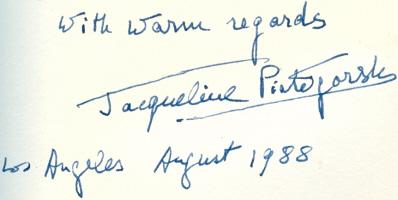
From one of our inscribed copies of Jump in the Waves
‘A few years later, when my children were both away and Grisha [her husband] was starting to age, I did quit tournament chess. I was still roaming around the world with a distorted perspective, crushed by meaningless losses or overelated by meaningless wins. I had played since I was six years old. Chess had an obsessional grip on me, chess was my friend, my support. Chess was a refuge from unfairness. It had become part of my blood. Still, today, when I am exhausted and sad, when hope disappears, my natural impulse is to flop in front of a chess board and start pushing pieces. Variations take form; rush forward, retreat, attack, defend – no, an error, try again. Interest and vitality reborn flow into combinations, soon become storms, a typhoon in a teacup. It is ironic that chess and its combinations which are so sterile also awake a passion, bring life. On the little board, pieces grow and shrink like birds in a muddy marsh.’
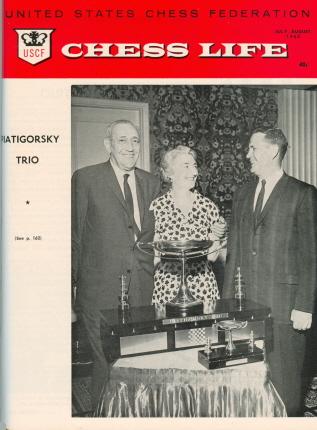
Chess Life, July-August
1963: Gregor Piatigorsky, Jacqueline Piatigorsky and Jerry Spann

Chess Review, September 1963, page 287

Chess Review, October 1966, page 309
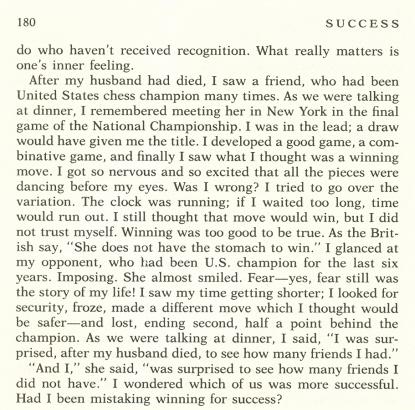
In C.N. 3178 (see page 247 of Chess Facts and Fables) a correspondent mentioned an elementary mistake on page 89 of The New York Times Guide to Good Chess by I.A. Horowitz (New York, 1969):
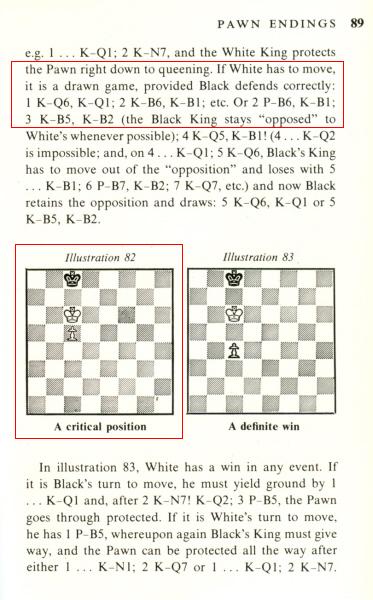
It remains a mystery why Horowitz wrote that Black could draw with 1 Kd6 Kd8 2 c6 Kc8 3 Kc5 Kc7, with no mention of 3 c7, but we now note that he handled a comparable position correctly in his article ‘How to win in the Ending’ on page 332 of the November 1955 Chess Review:
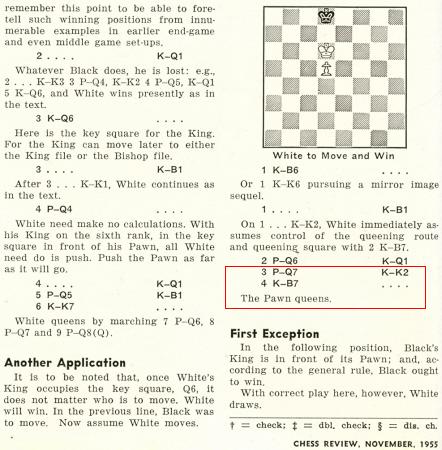
Wanted: instances of youthful chess achievements beyond the board. For example, William Jones (1746-94) wrote the ‘Caissa poem’ while in his teens, in 1763. It was published in 1772, and in his Preface he remarked:
‘It will be needless, I hope, to apologize for the Pastoral, and the poem upon Chess, which were done as early as at the age of 16 or 17 years, and were saved from the fire, in preference to a great many others, because they seemed more correctly versified than the rest.’
In quoting the above we are following the text on page 199 of The Poetical Works of Sir William Jones, volume 1 (London, 1810), which had this frontispiece:
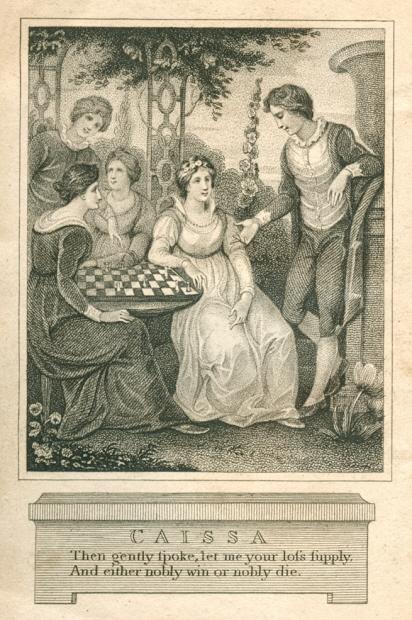
The provisions below, from pages 34-35 of The British Chess Code (London, 1903), may be regarded as a dogged attempt to stamp out enjoyment of the game:
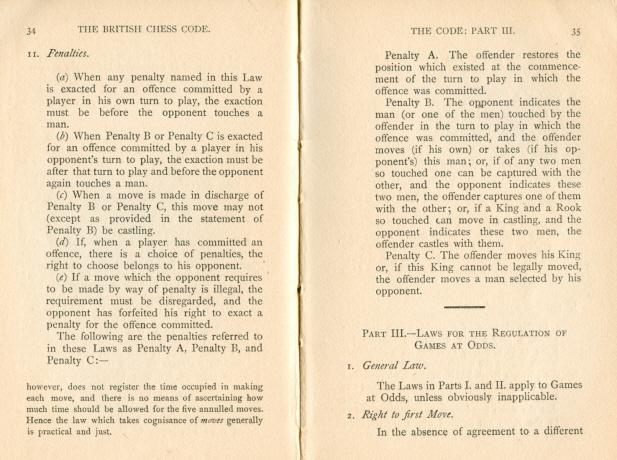
Some further photographs are presented:
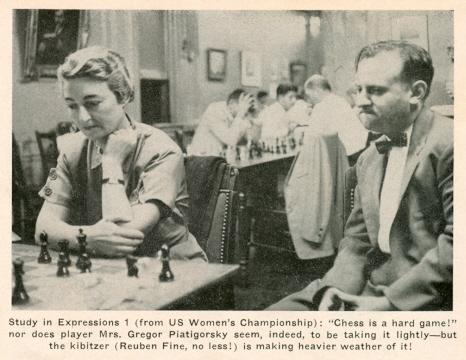
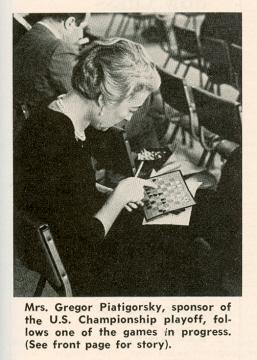
Sources: Chess Review,
October 1955, page 291; Chess Life, March 1963, page
73
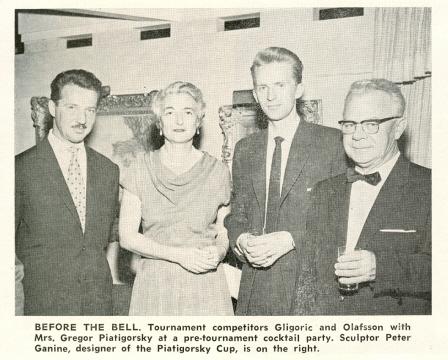
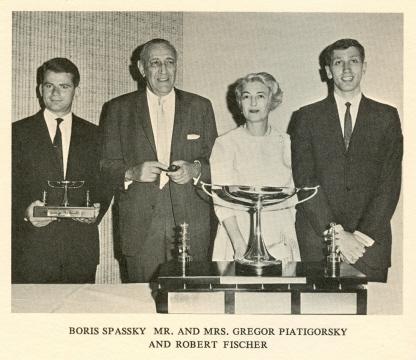
Sources: Chess Life,
July-August 1963, page 166; Frontispiece, Second
Piatigorsky Cup (published in Los Angeles, 1968)
Leonard Barden (London) notes a victory by Jacqueline Piatigorsky against Merete Haahr at Emmen, 12 September 1957, as given at the OlimpBase website.
We have been struck by how few of her games were published in US chess magazines. Here is a rare specimen, from page 23 of the January 1952 Chess Review:
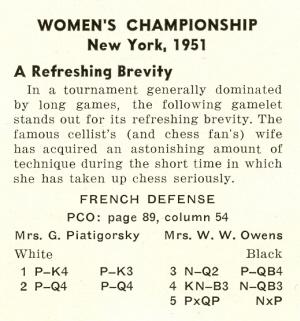
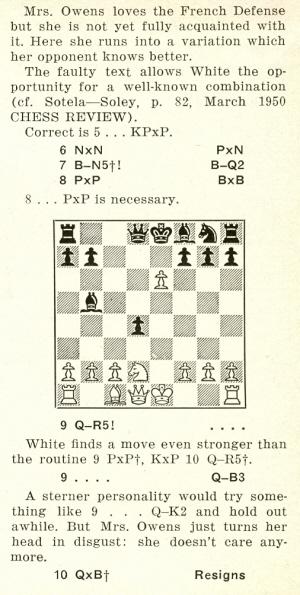
In reality, the play as far as 9 Qh5 had already been seen, with a transposition of moves, in a game won by Alekhine against Sánchez in Bogotá in March 1939. It was published on page 35 of the March-April 1939 American Chess Bulletin and, with notes by Tartakower, on pages 410-412 of the September 1939 BCM. Alekhine mentioned the opening on page 128 of his book Gran Ajedrez (Madrid, 1947); see also page 64 of 107 Great Chess Battles (Oxford, 1980).
The encounter was described by Alekhine as ‘una partida de exhibición contra el campeón de Bolivia, Sánchez, en Bogotá, marzo de 1939’. There is no reason why a Bolivian should not play a game in Colombia, but verification of Sánchez’s identity is sought. The above-mentioned item in the American Chess Bulletin described him as the ‘winner of the 1938 “Olympic” tournament at Bogotá’.
‘Schach in seiner gegenwärtigen Gestalt wird bald den Tod des Remis erleiden’, wrote Emanuel Lasker in his booklet Mein Wettkampf mit Capablanca (see pages 32-33 of the 1926 edition). The English translation on page 249 of the July 1921 BCM was: ‘Chess in its present form will die the death of the draw.’
For some comments by Capablanca, made while he was still world champion, see Capablanca on Moscow, 1925, as well as C.N. 4228. The latter item reproduced a remark by him written on 15 November 1925:
‘Chess is becoming so easy to play that very soon there will be several unbeatable players.’
It may be wondered when the Cuban first formed such a view, and one oddity, currently inexplicable to us, is a letter from C.Y.C. Dawbarn of Liverpool on pages 184-185 of the May 1922 BCM. It began:
‘In the course of his match with Dr Lasker, Señor Capablanca hazarded the opinion that chess was in fact exhausted; that, as in billiards or croquet, other reasons rather than the game itself determined the issue ...’
For his part, Capablanca stated a couple of months later:
‘I have been quoted as saying that chess has reached its limit. I never said anything of the kind. Somebody else made some such remark, and even he was misquoted.’
Source: The Times, 19 July 1922, page 15.
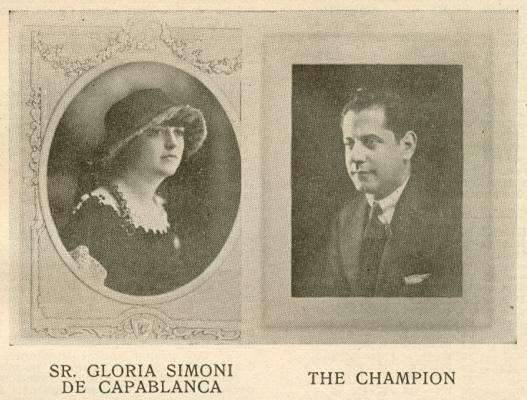
Illustration on page 177 of the December 1922 American Chess Bulletin

The above photograph shows the eminent scientist Sir Robert Robinson (1886-1975) giving a simultaneous exhibition in Oxford on 15 October 1947. Source: CHESS, December 1947, page 64. Page 3 of the same magazine’s October 1950 issue had this portrait, together with a brief contribution by him on Kriegspiel:
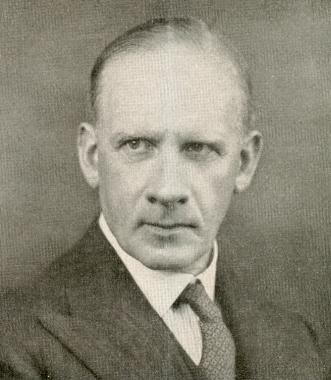
Sir Robert Robinson
Some games by him are given in databases, including the draw below, which he annotated on page 126 of the May 1957 BCM:
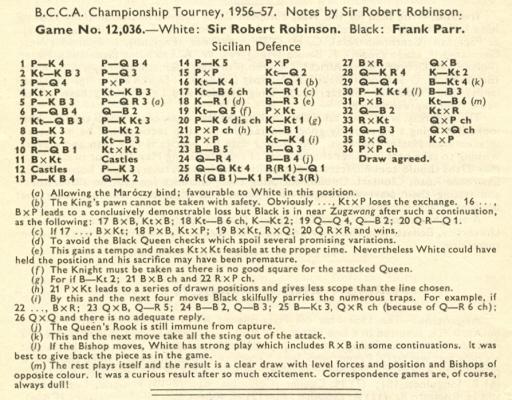
Russell Miller (Camas, WA, USA) and W.D. Rubinstein (Aberystwyth, Wales) have been examining on-line sources, and particularly the website ancestry.com, for information about Francis J. Wellmuth.
There is a death record for a person named Frank J. Wellmuth: born on 27 January 1866 in Missouri and died on 29 December 1943 in California. His mother’s surname was given as Ferney. The federal census of 1880 listed a Frank Welmouth (born circa 1866 in Missouri) who was attending school in Saint Joseph, Missouri and living with his mother, Celia Welmouth, a widow, and his siblings.
From Christian Sánchez (Rosario, Argentina):
‘According to the Colombian master Luis Augusto Sánchez, in a text quoted in a review of the book Jaque al olvido by Boris de Greiff, he was defeated by Alekhine in 1939: “[Alekhine], que me derrotó en las simultáneas del año 39 ...”
A question that arises is whether Luis Sánchez was “the Bolivian champion” or “the Bolivarian champion”. Support for the latter version is to be found at the Ajedrez en Colombia website, with this reference: “del campeón bolivariano Luis Augusto Sánchez”. The adjective “bolivariano” refers to the Colombian region Bolivar, and not to the country Bolivia. However, it is hard to know whether, assuming that there was confusion between Bolivarian and Bolivian, it was created by Alekhine or by somebody involved in his (posthumous) book Gran Ajedrez.’
We do not have a copy of Jaque al olvido and shall be grateful to any reader who can help us to acquire one.
On 5 December 1924 Norman Thorne (1900-25) of Crowborough, England dismembered his fiancée Elsie Cameron. Earlier that day he had bought ‘a game of chess’ in Tunbridge Wells. Source: page 114 of The Trial of Norman Thorne by Helena Normanton (London, circa 1929). Much has been written about that famous murder case, but we recall no other reference to chess in connection with the life of Thorne, who was hanged on 22 April 1925.
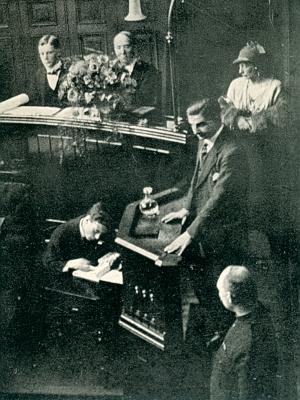
John Norman Holmes Thorne giving evidence at his trial, Lewes, 13 March 1925
A fine account of the case appeared on pages 88-126 of Verdict in Dispute by Edgar Lustgarten (London, 1949). From page 108:
‘Spilsbury [the pathologist Sir Bernard Spilsbury, who was the prosecution’s expert witness] had indeed done what few can hope to do; he had become a legend in his own lifetime. To the man in the street he stood for pathology as Hobbs stood for cricket or Dempsey for boxing or Capablanca for chess.’
| First column | << previous | Archives [43] | next >> | Current column |
Copyright: Edward Winter. All rights reserved.